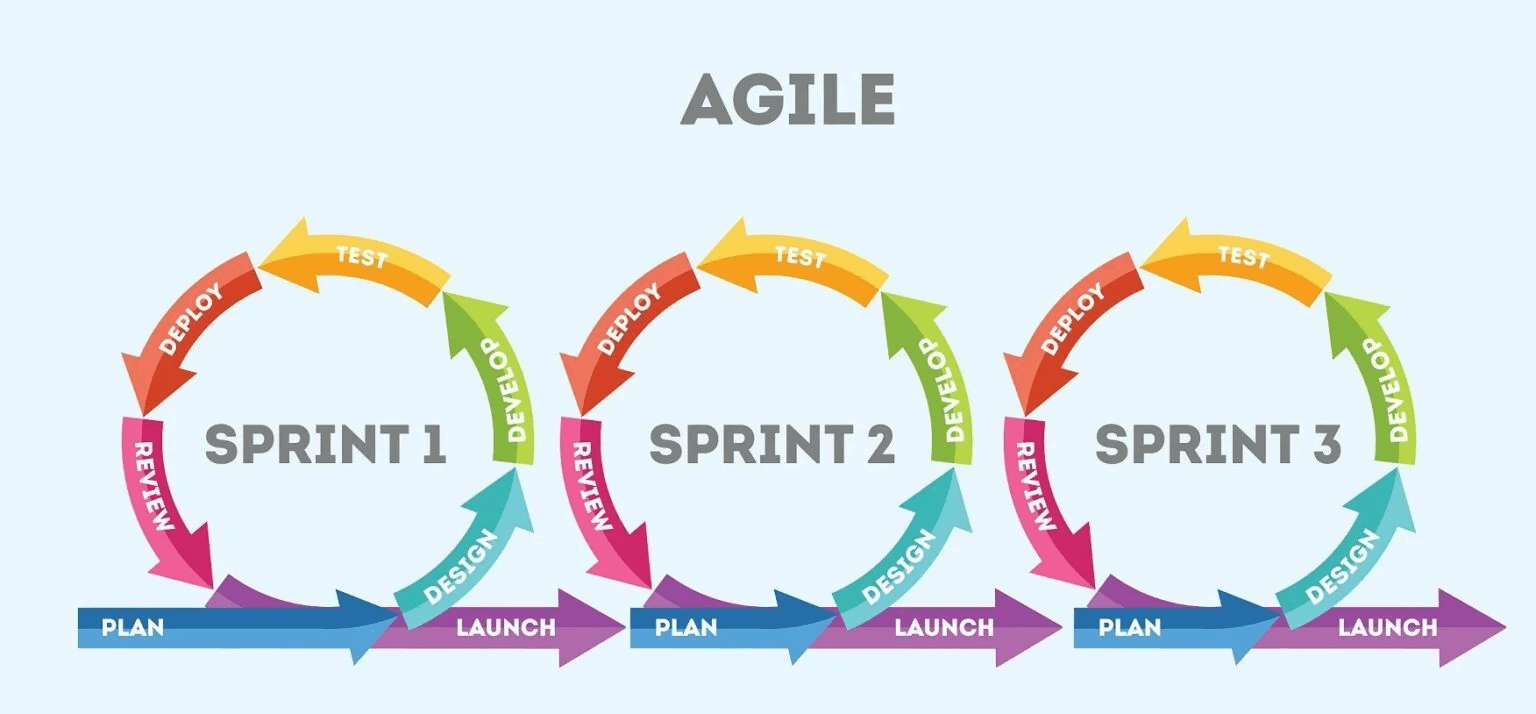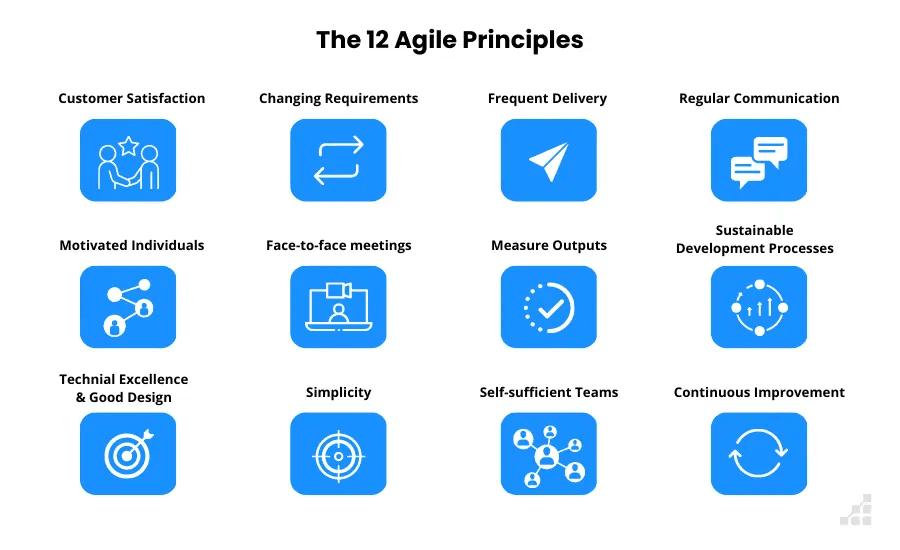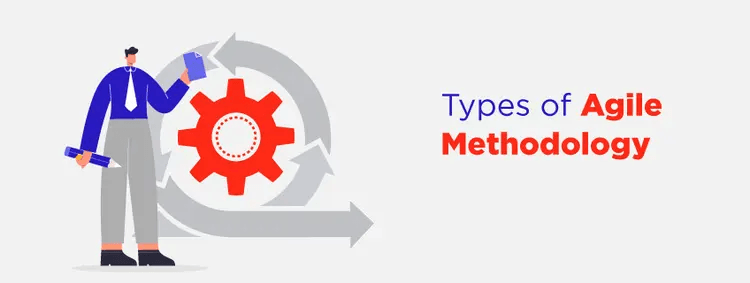Agile development methodologies play a vital role in enabling developers to create solutions in a flexible and iterative manner. They have become indispensable tools for developers of almost every software development company tasked with meeting the needs of users whose requirements are subject to change.
Selecting the right development methodology at the project’s outset, based on project requirements and available resources, is crucial to achieving the best possible results throughout the process.
This guide delves into the essence of the Agile methodology and how product managers and owners can employ various techniques to enhance software development and project management. Additionally, it explores how top software development companies should leverage the Agile methodology to enhance productivity and prioritize their initiatives effectively..
What is Agile Software Development?

A group of software designers, dissatisfied with the complexity and heavy documentation of conventional development processes, introduced Agile development methodologies as a more streamlined alternative.
Agile methodology is a project management framework that divides projects into dynamic phases called sprints. It operates on an iterative approach, with teams regularly reflecting on their progress after each sprint to identify areas for improvement and adjust their strategy for the next phase.
One of Agile’s key benefits is its ability to effectively address changes and refinements to the original model, ultimately resulting in superior software. Even when customer requirements shift, and development plans deviate from initial estimates, Agile development methodology readily accommodates these changes, efficiently integrating them into the project.
In a dynamic software development landscape, Agile stands out as a flexible and responsive approach that empowers teams to deliver quality results, even in the face of evolving project requirements.
What are the 12 Agile Principles?
The four pillars of Agile are the pillars of Agile software development methodology.
- Individuals and interactions
- Working software
- Customer collaboration
- Responding to change
The principles are derived from these weight-bearing pillars. Let’s have a look at these principles that can be easily adapted to fit the needs of your team.

-
Customer Satisfaction through Early Delivery
Ensuring customer satisfaction by providing regular updates allows customers to witness the desired changes promptly. This practice results in happier, more content customers and increased recurring revenue.
-
Embrace Changing Requirements
The Agile framework places a high value on adaptability. In iterative processes like Agile, flexibility is crucial; resisting change can be detrimental to project success.
-
Consistent Value Delivery
Consistently delivering value to customer stakeholders is a core Agile principle. This approach minimizes the risk of customer churn, aligning with the ultimate goal of customer satisfaction.
-
Breaking Down Project Silos
Collaboration is at the heart of the Agile development framework. Encouraging individuals to transcend the boundaries of their individual projects fosters a sense of unity and collective effort.
-
Motivated Team-Centric Projects
Agile thrives when teams are motivated and actively pursuing common goals. The commitment and active involvement of team members are pivotal to the framework’s success.
-
Effective Communication
Face-to-Face Preferred: While face-to-face communication is optimal, Agile teams adapt to distributed work environments by utilizing technology like Zoom calls to ensure effective communication.
-
Working Software as the Measure of Progress
Agile emphasizes that functional software is the primary measure of progress. This focus prioritizes the development of a successful product over other considerations.
-
Maintain a Sustainable Pace
While some aspects of Agile can be fast-paced, it’s important to strike a balance that prevents team members from burning out. The goal is to ensure sustainability throughout the project, enabling consistent and productive progress.
-
Continuous Excellence Enhances Agility
Achieving excellence in code development within a single sprint is a significant Agile principle. Building upon a foundation of excellent work in each iteration allows teams to accelerate their progress in future phases.
-
Simplicity is Essential
Agile emphasizes the value of simplicity. In many cases, the simplest solution is the most effective. This principle encourages avoiding unnecessary complexity and finding straightforward answers to complex problems.
-
Self-Organizing Teams Generate Value
Building upon the previous principle, Agile teams are expected to be self-organizing. Proactive and collaborative teams are invaluable assets to a company as they actively work to deliver value and meet project goals.
-
Regular Reflection and Adjustment for Improved Effectiveness
Agile promotes the practice of regular retrospective meetings. These meetings provide dedicated time for teams to look back, assess their performance, and adapt their behaviors and strategies for the future. This ongoing improvement agile development process enhances the team’s effectiveness and the overall success of the project.
What are some of the benefits of the Agile Development methodology
1. Efficient Planning and Workflow Management
Agile encourages dynamic funding, cost accounting, and project management, streamlining planning and workflows.
2. Market Disruption Response
Continuous customer feedback and short feedback loops enable organizations to predict and respond effectively to market disruptions.
3. Market-Responsive Agility
Agile practices, such as shorter planning cycles and adaptive governance, enhance the ability to respond to market changes.
4. Enhanced Visibility
Visual management tools promote greater visibility across the organization.
5. Alignment with Organizational Strategy
Agile metrics like objectives and key results (OKRs) and Program Increment (PI) planning stimulate regular strategy conversations, ensuring alignment with team activities.
6. Proactive Solution Development
Agile emphasizes customer collaboration and feedback, fostering proactive solution development.
7. Stability and Sustainability
Long-lived, self-sustaining teams promote stability and sustainability within the organization.
What are the main agile methodologies?

1. Kanban
Derived from Japanese, ‘Kanban’ translates to “visual board” and is linked to the “just in time” concept. Originally a lean manufacturing system, it has found its way into agile software development. Kanban relies on visual methods for project development and management.
A Kanban Board is the key tool in this approach, divided into columns that represent the custom software development process flow. It enhances team visibility, allowing them to monitor progress across every development stage, ensuring timely product delivery.
Kanban thrives on interaction and transparency, ensuring that team members always know the current software or web app development stage. This promotes a smooth and cohesive workflow, aligning with the “just in time” principle. Kanban’s simplicity and visual approach make it a valuable methodology for managing projects efficiently.
2. Scrum
Scrum stands out as a popular Agile methodology, emphasizing collaboration, speed, quality, cooperation, and iterative development. Ideal for small teams, it revolves around the concept of sprints.
A Scrum master leads the team, primarily focused on clearing obstacles hindering day-to-day work.
In daily meetings, Scrum teams discuss ongoing tasks, roadblocks, and any issues affecting the custom software development process.
- Sprint planning kicks off each sprint, defining what can be achieved and how.
- Sprint retrospective, another essential event, serves as a review, allowing the team to learn from the previous sprint and refine processes for the next one. Scrum’s core principles make it a valuable approach for efficient teamwork and development.
3. Extreme Programming (XP)
Extreme Programming (XP) is an Agile model rooted in essential principles like:
- Customer involvement
- Test-driven development
- Application security testing
- Frequent releases
It strongly focuses on pair programming, continuous integration, and short development cycles. This approach offers numerous benefits, including the creation of stable solutions and the prevention of errors during development. Additionally, involving the customer throughout the development process elevates the quality of the final solution.
The five values of Extreme programming are:
- Courage
- Simplicity
- Communication
- Respect
- Feedback
Like daily Scrum standups, XP features regular releases and iterations, but it’s notably more technical in its approach. It’s an excellent choice for software development service providers needing to swiftly release and respond to customer requests, prioritizing the ‘how’ of getting things done effectively.
4. Dynamic systems development method
The Dynamic Systems Development Method (DSDM) is an Agile approach that places a strong emphasis on the entire project lifecycle. Unlike some other Agile methods, DSDM is known for its more structured and strong foundation.
There are four main phases of DSDM:
- Feasibility and business study
- Functional mode or prototype iteration
- Design and build iteration
- Implementation
DSDM encourages developers to work swiftly and allows for the incorporation of changes in UI design through iterative development. However, businesses should be aware of the potentially significant implementation costs associated with this approach. DSDM’s comprehensive approach to the project lifecycle makes it a valuable methodology, but it may require a substantial investment to reap its benefits.
5. Adaptive software development
The Agile Software Development (ASD) methodology prioritizes adaptability to changing requirements. It’s all about continual adaptation. The project flows through phases—speculate, collaborate, and learn—which foster ongoing learning as the project evolves.
Teams in ASD often find themselves in all three phases simultaneously. This non-linear structure often leads to overlapping phases. Thanks to this flexible management approach, teams can quickly identify and resolve issues. The frequent repetition of these phases accelerates problem-solving, making ASD more agile compared to traditional project management methods.
6. Feature-driven development
Feature-driven development is an Agile methodology that blends various best practices. It’s an iterative project management approach but with a distinct focus on the specific software features being developed. Customer input plays a crucial role, as the prioritized features align with customer needs.
This model also supports frequent project updates and quick error correction. Its phases are in constant motion, enabling swift adjustments and fixes, making it highly responsive to evolving project requirements.
7. Behavior-driven development
Behavior-driven development (BDD), introduced by Dan North in 2003, is an agile methodology centered around behavior and communication. BDD employs common language concepts to foster effective communication within software projects, bridging the gap between technical and non-technical team members.
The BDD process revolves around the creation of test cases and features, serving as guidelines and requirements for the system’s proper operation. It defines the necessary functionality, the subsequent actions, and the expected results upon completion. Teams using BDD benefit from clear communication, swift bug identification, and the development of robust and enduring software solutions.
How to know if Agile Development Methodologies is right for your team?
Before selecting the right project management style for your team, it’s essential to ask a few key questions. It’s also worth noting that a combination of both agile and traditional methods can be effective. To decide when to use agile project management, consider the following factors:
1. Do senior management support agile processes?
To determine if methodologies are a good fit, consider senior management’s support. Everyone, including senior management, must be aligned and open to change with a degree of flexibility. Conversely, if your team is resistant to deviating from their established methods and finds the idea overwhelming, agile may not be the ideal choice.
2. Is this a recent concept or an established one?
When choosing between project management methods, evaluate the nature of your project. Is it an update to an existing process, or are you building something entirely new?
For projects involving updates to existing processes, traditional project management methods are likely more suitable. Agile is often the preferred choice for entirely new projects, although not all new projects automatically fit the agile approach. The following questions will help you further refine your decision if you’re unsure about the best approach.
3. When do you need it?
Agile excels when you’re dealing with short turnaround times and tight deadlines. These constraints can act as catalysts for your project, enabling faster adaptations when required.
In essence, it comes down to this: do you prioritize speed or perfection? If your aim is to swiftly release the first version, and you’re willing to trade perfection for innovation, opt for an agile product development approach. However, if top-notch quality is your primary concern, then a more traditional approach may be the better choice. Additionally, it’s crucial to assess whether your team is equipped to support agile processes
4. How does your team handle change?
Flexibility isn’t only essential for senior management; the entire team’s adaptability matters. It’s crucial to honestly evaluate how your team responds to change to determine if agile is a suitable fit.
If you have only a few change-averse employees, you can address this on an individual basis. However, if your entire team is resistant to altering existing procedures, it may not be advisable to disrupt the status quo. The decision rests with you.
5. Is your team full of independent thinkers?
Consider your team’s thinking style. Do they thrive when thinking freely and working independently, or do they perform better with guidance and teamwork to arrive at solutions?
Traditional methods align well with those who think in linear, step-by-step solutions. Agile, on the other hand, suits teams that require a more creative and unconventional approach, venturing beyond established procedures to develop innovative solutions.
6. What approach are you currently using?
Consider your existing systems: Are they rigid and structured, or does your team have the freedom to carry out their work as they deem appropriate?
This single question can offer valuable insights into which management style aligns better with your project and team. If you’re already adhering to stringent processes, transitioning to agile might be more time-consuming than anticipated.
7. Is your industry fast-paced with frequent changes?
Assess your industry’s pace of product launches and changes. If your latest feature becomes outdated rapidly, traditional project management may not be viable.
Opting for agile allows you to swiftly adapt, staying ahead of your competitors. Those in industries where products have longer agile software development life cycle may find greater benefits in traditional, waterfall methods.
These seven questions can assist you in determining if an agile software development methodology is suitable for your upcoming project.
If you opt for a combination of agile and traditional project management methods, it’s crucial to establish clear processes that dictate when each method should be employed. This ensures that everyone on your team remains aligned and on the same page throughout the project.
Conclusion
Agile development methodologies offer an efficient approach to render custom software development services. When development teams prioritize collaboration, continuous delivery, and customer-focused development, the products they create tend to be more reliable.
If you’re interested in further insights into agile software development and how to approach it professionally, don’t hesitate to reach out to our experts at DianApps, your trusted custom software development company. We’re here to provide you with the guidance and roadmap to help you achieve your goals.










Leave a Comment
Your email address will not be published. Required fields are marked *